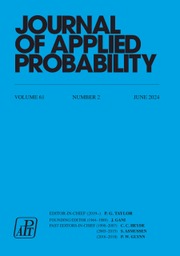No CrossRef data available.
Article contents
Integral stochastic orders with parametric classes of functions
Published online by Cambridge University Press: 01 October 2025
Abstract
This paper introduces the general ideas for parametric integral stochastic orders, with which a continuum of parametric functions are defined as a bridge between different classes of non-parametric functions. This approach allows one to identify a parametric function class over which two given random variables may violate the non-parametric stochastic order with specific patterns. The parameter used to name the parametric function class also measures the ratio of dominance violation for the corresponding non-parametric stochastic orders. Our framework, expanding the domain of stochastic orders, covers the existing studies of almost stochastic dominance. This leads to intuitive explanations and simpler proofs of existing results and their extensions.
MSC classification
Information
- Type
- Original Article
- Information
- Copyright
- © The Author(s), 2025. Published by Cambridge University Press on behalf of Applied Probability Trust


